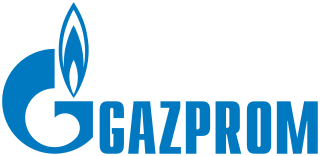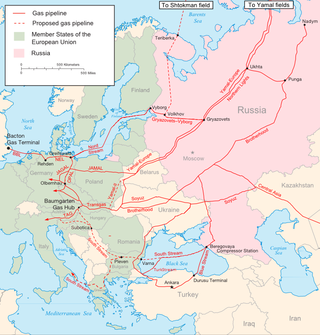
PJSC Gazprom is a Russian majority state-owned multinational energy corporation headquartered in the Lakhta Center in Saint Petersburg. The Gazprom name is a contraction of the Russian words gazovaya promyshlennost. In January 2022, Gazprom displaced Sberbank from the first place in the list of the largest company in Russia by market capitalization. In 2022, the company's revenue amounted to 8 trillion rubles.

The Russia–Ukraine gas disputes refer to a number of disputes between Ukrainian oil and gas company Naftogaz Ukrayiny and Russian gas supplier Gazprom over natural gas supplies, prices, and debts. These disputes have grown beyond simple business disputes into transnational political issues—involving political leaders from several countries—that threaten natural gas supplies in numerous European countries dependent on natural gas imports from Russian suppliers, which are transported through Ukraine. Russia provides approximately a quarter of the natural gas consumed in the European Union; approximately 80% of those exports travel through pipelines across Ukrainian soil prior to arriving in the EU.
Nord Stream is a pair of offshore natural gas pipelines in Europe that run under the Baltic Sea from Russia to Germany. It consists of the Nord Stream 1 (NS1) pipeline running from Vyborg in northwestern Russia, near Finland, and the Nord Stream 2 (NS2) pipeline running from Ust-Luga in northwestern Russia near Estonia. Both pipelines run to Lubmin in the northeastern German state of Mecklenburg-Vorpommern. Each pipeline contains two pipes, denoted A and B; each of the four pipes is approximately 1,200 kilometres (750 mi) long and with approximate diameters of 1,220 millimetres (48 in). The combined capacity of the four pipes is 110 billion cubic metres per annum of natural gas.
RosUkrEnergo is a Swiss-registered venture company that transports natural gas from Turkmenistan to East European countries. 50% of the company is owned by Gazprom, through its subsidiary Swiss-registered Rosgas Holding A.G., and another 50% by Swiss-registered private company Centragas Holding A.G., acting on behalf of a consortium of GDF Group owned by Dmytro Firtash and Ivan Fursin.

The Yamal–Europe natural gas pipeline is a 4,107-kilometre-long (2,552 mi) pipeline connecting Russian natural gas fields in the Yamal Peninsula and Western Siberia with Poland and Germany, through Belarus. The Poland portion ceased operating in 2022.

Russia's energy policy is presented in the government's Energy Strategy document, first approved in 2000, which sets out the government's policy to 2020. The Energy Strategy outlines several key priorities: increased energy efficiency, reducing the impact on the environment, sustainable development, energy development and technological development, as well as improved effectiveness and competitiveness. Russia's greenhouse gas emissions are large because of its energy policy. Russia is rich in natural energy resources and is one of the world's energy superpowers. Russia is the world's leading net energy exporter, and was a major supplier to the European Union until the Russian invasion of Ukraine. Russia has signed and ratified the Kyoto Protocol and Paris Agreement. Numerous scholars posit that Russia uses its energy exports as a foreign policy instrument towards other countries.

The Urengoy–Pomary–Uzhhorod pipeline is one of Russia's main natural gas export pipelines, partially owned and operated by Ukraine. It was part of the "gas in exchange for pipes program", and the Soviet-controlled bank "Ost-West Handelsbank" was opened in Frankfurt on 1 March 1973 to support the project.

The 2005–06 Russia–Ukraine gas dispute was between Ukrainian state-controlled oil and gas company Naftogaz Ukrainy and Russian national gas supplier Gazprom. The disagreements concerned natural gas supplies, prices and debts. The conflict started in March 2005, ended in January 2006 and, in addition to the gas companies, involved politicians from both countries.

In 2009, Russian natural gas company Gazprom refused to conclude a supply contract unless Ukrainian gas company Naftogaz paid its accumulating debts for previous gas supplies. The dispute began in the closing weeks of 2008 with a series of failed negotiations, and on January 1, 2009 Russia cut off gas supplies to Ukraine. On January 7 the dispute turned to crisis when all Russian gas flows through Ukraine were halted for 13 days, completely cutting off supplies to Southeastern Europe, most of which depends on Russian gas, and partially to other European countries.

Russia supplies a significant volume of fossil fuels to other European countries. In 2021, it was the largest exporter of oil and natural gas to the European Union, (90%) and 40% of gas consumed in the EU came from Russia.
Ukraine extracts about 20 billion cubic meters of fossil gas each year, and since 2022 this has almost met demand. Ukraine has been estimated to possess natural gas reserves of over 670 billion cubic meters (in 2022), and in 2018 was ranked 26th among countries with proved reserves of natural gas. In 2021, Ukraine produced 19.8 billion cubic meters (bcm or Gm3) of natural gas. To satisfy domestic demand of 27.3 bcm that year, Ukraine relied on gas imports (2.6 bcm) and withdrawal from underground storage (4.9 bcm). Winter demand can reach 150 mcm per day.
Chornomornaftogaz is an oil and gas company located along Krymgazseti in Simferopol, Crimea. The company was established with the order of the Ministry of Gas Industry of the USSR on 20 October 1978 №209-org to develop oil and gas resources in the Black Sea and the Sea of Azov.

In 2021 Russia was the world's second-largest producer of natural gas, producing an estimated 701 billion cubic meters (bcm) of gas a year, and the world's largest natural gas exporter, shipping an estimated 250 bcm a year. In 2022 the export market was significantly downsized, following the Russian invasion of Ukraine and Russia reducing exports after countries refused to pay in rubles.
Andríy Kóbolyev is a Ukrainian politician and businessman, and the former chief executive officer of Ukrainian largest company, the state-owned oil and gas company Naftogaz. In October 2014, Kobolyev was named a global "Top 40 under 40" leader by Fortune in recognition of his anti-corruption reform successes.

Yuriy Yuriyovych Vitrenko is a Ukrainian businessman.
Nord Stream 2 is a 1,234-kilometre-long (767 mi) natural gas pipeline from Russia to Germany running through the Baltic Sea, financed by Gazprom and several European energy companies. Feasibility studies began in 2011 to expand the Nord Stream 1 line and double annual capacity to 110 billion cubic metres, with construction beginning in 2018. It was completed in September 2021, but has not yet entered service. Planning and construction of the pipeline were mired in political controversy over fears that Russia would use it, one of 23 pipelines between Europe and Russia, for geopolitical advantage with Europe and Ukraine.

The Russia–EU gas dispute flared up in March 2022 following the invasion of Ukraine on 24 February 2022. Russia and the major EU countries clashed over the issue of payment for natural gas pipelined to Europe by Russia's Gazprom, amidst sanctions on Russia that were expanded in response to Russia's 2022 invasion of Ukraine. In June, Gazprom claimed it was obliged to cut the flow of gas to Germany by more than half, as a result of such sanctions that prevented the Russian company from receiving its turbine component from Canada. On 26 September 2022, three of the four pipes of the Nord Stream 1 and 2 gas pipelines were sabotaged. This resulted in a record release of 115,000 tonnes of methane (CH4) – an equivalent of 15 million tonnes of carbon dioxide (CO2) – and is believed to have made a contribution to global warming.
Stop Bloody Energy project is a global initiative of Ukrainian energy companies aimed at refusing to buy Russian energy resources and cooperating with Russia in the energy sector due to its war against Ukraine. The project was launched by Rinat Akhmetov's private company DTEK and the state-owned companies Naftogaz and Ukrenergo.
As part of the sanctions imposed on the Russian Federation as a result of the Russo-Ukrainian War, on 3 December 2022, the European Union (EU) agreed to cap the price of natural gas in order to reduce the volatility created by Russia in the gas market.

The Lukoil oil transit dispute is an ongoing international relations dispute between Ukraine and the European Union at odds with Hungary and Slovakia regarding the allowance of the pipeline transfer of Russian oil through Ukrainian territory. The diplomatic standoff arose when Ukraine imposed sanctions on Lukoil — Russia's largest private oil firm — effectively halting oil supplies to Hungary and Slovakia via the Druzhba pipeline, which the latter two nations stated would lead to an energy crisis and economic collapse. In response, Hungary and Slovakia complained to the European Commission while threatening to halt military aid shipments, energy, and diesel supplies to Ukraine.











